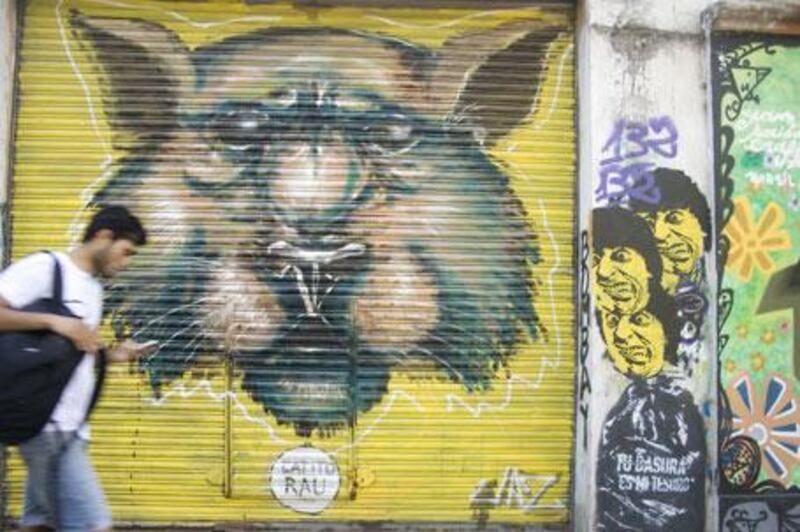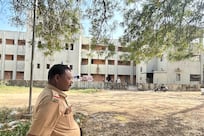It's a balmy Friday night in Buenos Aires. The Espacio Cultural Bonpland is heaving, with cool kids watching a series of angsty bands take turns entertaining them. But this isn't just about escapist revelry, for out in the cultural centre's open courtyard, it's an altogether different atmosphere. Groups of artists are working furiously to make sure that every available inch of wall space is covered with a giant, free-for-all mural made from retro 1980s graffiti to pop art stencils. Some use traditional brushes while others wave their arms around like enthusiastic air-traffic controllers as they cover the wall with aerosol paint.
Creative scenes such as this have become commonplace in a city that is fast becoming a major contender for the title of world street art capital. The Bonpland event, which took place at the end of last year, was organised to celebrate the launch of a new book, Ojo Chino, compiled by the renowned local photographer Chino Zavlía. He has gone to great lengths to document the varied and highly skilled paintings, graffiti pieces and arte callejero (street art) that have sprung up over Argentina's cosmopolitan capital, much of it a response to the economic crisis of 2001-02. And while Buenos Aires clings to its clichés - and the oft-quoted accolade of being the "Paris of South America" - the wealth of artwork in public spaces not only shows that alternative counter-culture is alive and kicking, but also provides a fascinating prism for understanding the anomalies and oddities of this most European-leaning of capitals.
Walk around the northern suburbs of Buenos Aires and it won't be long before you encounter a piece of graffiti. It might be scrawled on a crumbling wall, an empty space outside a bus terminal or even a bin, but the chances are it will be a mini work of art. Maybe it will last for years, or maybe a cheeky artist will spray over it within hours, so prolific is the output from the streets. Palermo, Villa Crespo and Colegiales - quiet neighbourhoods of tree-lined avenues, low-rise houses and steak restaurants - are at the forefront of a movement that has been growing slowly since the 1990s. It took off following the collapse of the peso and the ensuing social chaos at the start of the new millennium, which caused a long period of self-reflection.
Fede Minuchin, a young stencil artist with a wispy beard and baggy T-shirt, tells me about his involvement in the scene and Buenos Aires's particular take on street art. "On the one hand you have the liberty to paint the city, even though it is not technically permitted," he says. "We are still a Third World country, so people are really happy to have a colourful mural on their homes. In First World countries you don't have this freedom. People are too uptight and consider graffiti in any form to be an act of vandalism."
The city's attitude towards graffiti is at best laissez-faire. The government has neither the resources nor the will to erase art that has been painted on private property. Residents certainly don't seem to hold the view that street art is a polluting influence or "social evil" that those in other countries often complain about. Maybe they simply believe there are more important issues. Whatever the case, there's a large variety of work that can be called street art, and it goes way beyond the second-grade tagging that is popular in the urban centres of America and Europe. The artists in Buenos Aires are from educated backgrounds (in fact, the areas they work in are solidly middle class neighbourhoods), and they all have highly individual styles. The environment is so good for flourishing artists that graffiti sprayers and street art sculptors from around the world have been encouraged to leave their mark.
Minuchin only really took up spraying eight years ago, shortly after the economic collapse. Like many people, he felt he needed to respond in some way. "Being able to do something with your hands felt great after the 2001 crash and the crisis," he says. "And being out on the streets as well." His work ranges from stencils of giant gorillas to more comical pieces. Other pieces- such as a stencil of a black bin liner on which the words "Your rubbish is my treasure" are scrawled - make strong social comments. The quote refers to the cartoneros, unofficial bin collectors who go through rubbish at night to find cardboard or other goods that they can recycle for cash. Asked if he is overtly political, Minuchin gives a humble answer. "I would say it's a mixture of a pop thing with irony and attitude. I don't think I've found my style yet. I'm still looking for it."
Minuchin is part of a collective of artists called Rundontwalk who meet up to spray huge murals around town. They were originally commissioned to paint a new venue, Post Bar, in the Palermo neighbourhood of Buenos Aires, covering the outside as well as the entire interior. The owner was so impressed that he invited the graffiti crew to get directly involved with the bar. They now occupy the top floor, where artwork is exhibited, events are held and merchandise is sold in their Hollywood in Cambodia gallery. Their success story shows how far graffiti has come within the past decade.
Other artists are more solitary, like Gaulicho, whose name means "curse". Inspired by 1960s San Francisco, he explores the magical and mystical, often painting in psychedelic colours. Then there's Jaz, one of the original artists from the northern Buenos Aires scene, who has been spraying on walls since the 1990s, when he was 13. Jaz uses cheap aerosols not because he can't afford more expensive ones, but because he likes the effect they have on the wall, looking like watercolours. He often paints animals (donkeys in particular) and has an image of a huge horse outside a bus depot. Decorated with giant swirls, the piece is influenced by the traditional fileteado street signs that were popular in the 19th and early 20th centuries and can still be seen around certain parts of town.
Other artists include Nema, who often paints elderly people, and the Bs As Stncl collective responsible for one of the city's most iconographic graffiti pieces, George W Bush with Mickey Mouse ears. Marina Charles, a Briton with an advertising background, moved to Buenos Aires a few years ago and was impressed with the street art she saw. Realising that the scene had huge tourism potential, she met various artists and became an expert on the scene's players and their work. The co-founder of Graffitimundo, which styles itself as an alternative walking tour of Buenos Aires, she now takes scores of tourists around residential neighbourhoods explaining the social and political background of the street art they see.
"People go away feeling really inspired by what they've seen," she says. "Such is the energy and prolificness of the Buenos Aires scene. There is something really raw and exciting going on here, and people pick up on that." Of course, with all the attention graffiti in Buenos Aires is receiving, it's rapidly shifting from an underground movement to fully-fledged part of mainstream consumer society. Just like many of the pioneering players from the 1980s and 1990s New York scene, many Argentine artists have started doing commissioned pieces for international companies and publicity agencies as the boundaries between artwork and advertising become blurred.
Examples of graffiti-style adverts seamlessly slotted beside street art can be seen all around town, with a recent example being the cartoon-like ads for animated film Boogie that popped up around many of Buenos Aires' most sprayed areas. Despite these undercurrents, the growth of awareness can only be a good thing, and with charities such as Arte Sin Techo encouraging homeless people to become street artists, these are excitingly hard to predict times for a scene that continues to grow at an almost exponential rate.
Graffiti is the language of the streets, whether it's expressing political dissatisfaction or simply making the world a more beautiful place. ? For more information on the Graffitimundo tour, the Arte Sin Techo charity or the artists, visit www.graffitimundo.com, www.artesintecho.org.ar or www.rundontwalk.com.ar.





